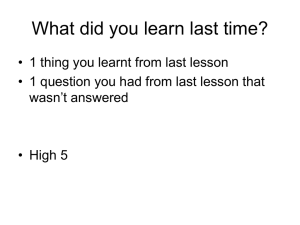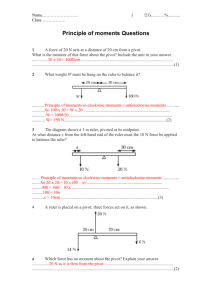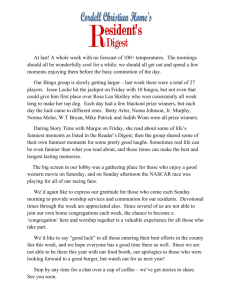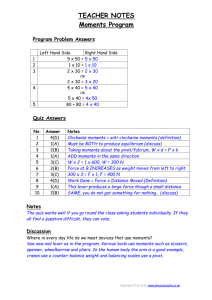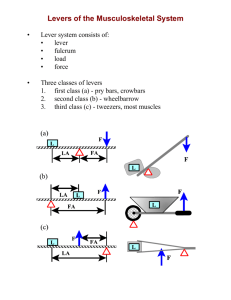Pressure - Cloudfront.net
advertisement
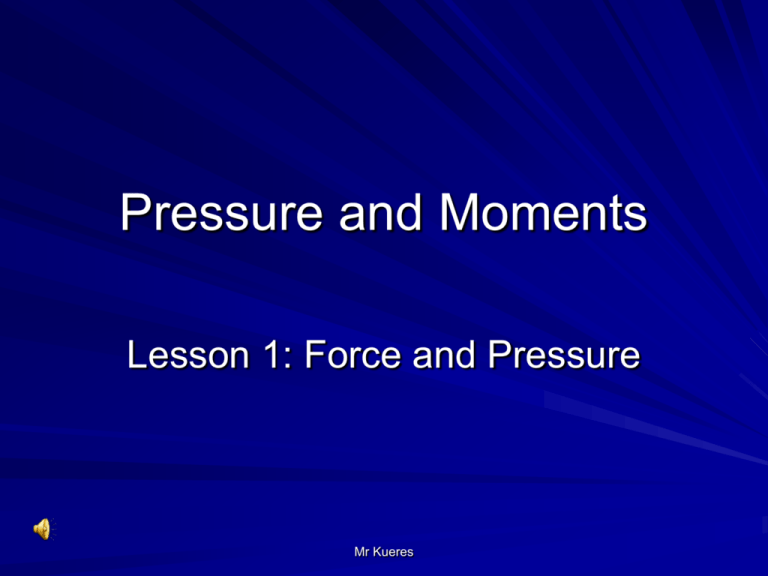
Pressure and Moments Lesson 1: Force and Pressure Mr Kueres Lesson Objectives 1. To know what a force does and about balanced and unbalanced forces – especially air resistance and friction 2. To know that pressure depends on the size of a force and the area over which it is exerted Mr Kueres What is a Force? What Can a Force Do? A force can change the: Size Shape Speed And Direction of an object Mr Kueres Balanced Forces If the forces on an object are balanced, they will have no effect on the motion of an object. I.e. The person (opposite) will remain still Or a car moving at 30mph with balanced forces acting on it, will continue to travel at 30mph Mr Kueres Unbalanced Forces If the forces on an object are unbalanced, they will have some effect on the object’s motion (either change the direction or cause the object to speed up or slow down. Will the car below speed up or slow down? Drag (Resistive forces) Thrust (driving force) Mr Kueres Pressure Pressure tells us about the effect of a force compared with the area over which it acts. Mr Kueres Things to Do Answer the questions on the worksheet ‘Big Pressure, Small Pressure’ – 10 minutes (H) Draw a table, as shown below, illustrating examples of large area/low pressure and small area/high pressure (F) Draw examples of things that will exert a high pressure because of its small surface area and a low pressure because of its large surface area. Large Area/Low Pressure Small Area/High Pressure Mr Kueres Homework Complete Worksheet ‘But Why?’ DUE IN: Next lesson If you have any questions about the homework, come and see me before it is due in. Mr Kueres Pressure and Moments Lesson 2: Calculating Pressure Mr Kueres Lesson Objectives 1. To recall and use the formula for pressure 2. To know the units for pressure, force and area 3. To be able to estimate area reliably Mr Kueres Pressure Pressure is dependent on f and a . If the f applied gets larger, the p will be h . If the a becomes larger, the pressure will be s . Mr Kueres Pressure Pressure is dependent on force and area. If the force applied gets larger, the pressure will be higher. If the area becomes larger, the pressure will be smaller. Mr Kueres Formula for Pressure Pressure = Force Area P= F A Force is measured in N , N. Area is measured in s m , m2. Pressure is measured in Newtons per square metre, N/m2 or P , Pa. Mr Kueres Formula for Pressure Pressure = Force Area P= F A Force is measured in Newtons, N. Area is measured in square metres, m2. Pressure is measured in Newtons per square metre, N/m2 or Pascals, Pa. Mr Kueres Finding the Pressure we Exert on the Floor APPARATUS cm Squared Paper Bathroom Scales METHOD Draw around your foot on the piece of squared paper. Count the squares and estimate the area of your foot (More than half a square counts as 1, less than half a square doesn’t count). Use the bathroom scales to find your body WEIGHT. Remember: weight is a force and measured in NEWTONS) (1kg ~ 10N). Calculate the pressure exerted by each foot, then both feet together. Mr Kueres Calculation for One Foot Pressure exerted by one foot = Half body weight Area of foot = = Mr Kueres N/cm2 Calculation for Both Feet Pressure exerted by one foot = Body weight 2 x Area of foot = = Mr Kueres N/cm2 Evaluation Give one reason why you think your experiment was accurate and one reason why you think your experiment was not very reliable Mr Kueres Things to Do (H) Answer the questions on the Pressure Practice Worksheet in your exercise books. (F) Complete the worksheet 9La/3: Pressure Points Mr Kueres Pressure and Moments Lesson 3: Compression of Liquids and Gases Mr Kueres Lesson Objectives 1. To review the formula for pressure 2. To know whether liquids and gases can be compressed 3. To know that liquids transmit pressure 4. To know that pressure increases with fluid depth Mr Kueres Pressure Formula As the force increases, pressure increases. If the surface area increases, pressure will decrease. Pressure = P= F A Mr Kueres Force Area Pressure = force/area. There is a direct relationship between pressure and force – increasing the force the pressure (provided that the area stays the same). There is an relationship between force and area – increasing the area decreases the pressure (provided that stays the same). If force is measured in , N, and area is measured in metres, m2, then the unit of pressure is the . The atmosphere exerts pressure. Outside the Earth’s , there is no air and no atmospheric pressure. Water also exerts pressure. Water exerts more pressure at greater . Mr Kueres Pressure Pressure = force/area. There is a direct relationship between pressure and force – increasing the force increases the pressure (provided that the area stays the same). There is an inverse relationship between pressure and area – increasing the area decreases the pressure (provided that force stays the same). If force is measured in Newtons, N, and area is measured in square metres, m2, then the unit of pressure is the Pascal. The atmosphere exerts pressure. Outside the Earth’s atmosphere, there is no air and no atmospheric pressure. Water also exerts pressure. Water exerts more pressure at greater depth. Mr Kueres Compression in Liquids and Gases In a gas, the are a long way apart and it’s not too hard to push them closer . In a , it’s very hard to particles much closer together. So, the particle model can explain the different of gases and liquids under . Mr Kueres G a s Ga s Compression in Liquids and Gases In a gas, the particles are a long way apart and it’s not too hard to push them closer together. In a liquid, it’s very hard to push particles much closer together. So, the particle model can explain the different behaviour of gases and liquids under pressure. Mr Kueres G a s Ga s Introduction to Hydraulics Many robots use hydraulics or liquid pressure. There are two cylinders – a master cylinder and a slave cylinder – connected by a sturdy pipe. The master cylinder contains the effort piston and the slave cylinder contains the load piston. The slave does everything that its master tells it to do, but it does it with more force than the master could manage. Hydraulics are also used in jacks to lift up cars. Mr Kueres The Hydraulic Jack Effort Small piston provides the effort but moves along way Hydraulic fluid Increased is pushed pressure through results in load being lifted X Non-Return Valve Mr Kueres Large piston lifts the load but doesn’t move as far Hydraulics If the load piston has an area 5 times that of the effort piston, the load lifted is 5 times the effort, BUT moves only 1/5 the distance. Mr Kueres Questions 1. Why do we use oil and not water in hydraulic machines? 2. What is the non-return valve for? 3. What would happen if there was an air bubble in the pipe work between two cylinders? Mr Kueres Motor Vehicle Brakes If liquids are useful because they are incompressible and air in hydraulic fluid prevents it working effectively, why do some vehicles have brakes operated by compressed air? Mr Kueres Hydraulics Review A system can convert a small force into a bigger force. The system is filled with liquid, which is . The force acting on the piston in the master cylinder acts over a small . The is transmitted through the liquid, so the same pressure acts on the piston in the slave cylinder, but it acts over a bigger area. The same pressure acting over a bigger area produces a bigger . A gas is of no use in a hydraulic system because it is . Pressure acting on a gas pushes the closer together. In a the particles are already close together and it’s very hard to make them closer. Mr Kueres Hydraulics Review A hydraulic system can convert a small force into a bigger force. The system is filled with liquid, which is incompressible. The force acting on the piston in the master cylinder acts over a small area. The pressure is transmitted through the liquid, so the same pressure acts on the piston in the slave cylinder, but it acts over a bigger area. The same pressure acting over a bigger area produces a bigger force. A gas is of no use in a hydraulic system because it is compressible. Pressure acting on a gas pushes the particles closer together. In a liquid the particles are already close together and it’s very hard to make them closer. Mr Kueres Deep Sea Diving Why does a diver need to breathe compressed air? The pressure of the water above him makes it hard to inhale with out the gas helping. The pressure is due to the mass of water above him. Pressure = Weight of water Area of diver The pressure exerted depends on: 1. the depth 2. the weight of the fluid (hence, its density) Mr Kueres Depth of water in metres 100 20 200 30 300 40 400 50 500 Mr Kueres Water pressure in kilopascals 10 Submarine Pressure Depth of water in metres Water pressure in kilopascals 10 100 20 200 30 300 40 400 50 500 Mr Kueres Things to Do Answer the Questions on the Submarine Pressure worksheet Answer the Questions on the Water Pressure worksheet Mr Kueres Submarine Pressure The bigger the depth of water, the b the water pressure is. For example, if the depth doubles then water pressure also d . And if the depth trebles then w p trebles. In fact, whenever the depth changes, the water pressure always changes by the same p . Mr Kueres Submarine Pressure The bigger the depth of water, the bigger the water pressure is. For example, if the depth doubles then water pressure also doubles . And if the depth trebles then water pressure trebles. In fact, whenever the depth changes, the water pressure always changes by the same proportion. Mr Kueres Pressure & Moments Lesson 4: Moments Mr Kueres Lesson Objectives 1. 2. 3. 4. 5. To know that a force can produce a turning effect To know that the turning effect is called a moment To know that the moment of a force depends on the size of the force and the distance of the force from the pivot To know that the pivot is also called a Fulcrum To be able to calculate the moment of a force Mr Kueres Turning Effects Write a list of examples of where a force produces a turning effect. Mr Kueres Demonstration Try opening a door in each of these three places: 1. A point furthest away from the hinges 2. A point roughly in the centre of the door 3. A point close to the hinges At which point is it the most difficult to open the door? Mr Kueres Demonstration Hold a metre ruler horizontally at arms length. If we apply a 10N weight near your hand, then gradually move the weight along the ruler, what happens? We find that it becomes increasingly difficult to hold the ruler horizontal. This is because the mass exerts a turning effect on the ruler. The turning effect is called a MOMENT and depends on the weight and the distance from the pivot Mr Kueres Moments The turning effect caused by a force is called a moment and depends on the force (weight) applied and the distance from the pivot. Mr Kueres Moments Moment = Force Exerted x Distance from the Pivot Moment = F x d UNITS Force is measured in N , N. Distance is measured in m , m (usually c , cm, for the distances we use in class). Moments are measured in N m , Nm (or Newton centimetres if the distance is measured in that unit) Mr Kueres Moments Moment = Force Exerted x Distance from the Pivot Moment = F x d UNITS Force is measured in Newtons, N. Distance is measured in metres, m (usually centimetres, cm, for the distances we use in class). Moments are measured in Newton metres, Nm (or Newton centimetres if the distance is measured in that unit). Mr Kueres Things to Do Complete 9Ld/3: Revision Questions Complete the Moments Example Sheet 1 Mr Kueres Balancing Act We can use the idea of moments to see why an object balances (or overbalances) G Centre of gravity acts between the wheels – the bus is balanced Mr Kueres G Centre of gravity acts outside of the wheels Things to Do Complete the Moments Example Sheet 2 Mr Kueres Pressure and Moments Lesson 5: Balancing Moments Mr Kueres Lesson 5 - Objectives 1. To know how to find whether moments are balanced or unbalanced 2. To be able to balance simple levers 3. To know that if a lever is balanced, the anticlockwise and clockwise moments are equal Mr Kueres Moments - Review Moment = Force Exerted x Distance from the Pivot Moment = F x d UNITS Force is measured in Newtons, N. Distance is measured in metres, m (usually centimetres, cm, for the distances we use in class). Moments are measured in Newton metres, Nm (or Newton centimetres if the distance is measured in that unit). Mr Kueres Balancing Levers How can we alter levers e.g. seesaws, so that they balance? In which direction would you move the masses to make the lever above balance? Could you balance the lever by moving the pivot? If so how? Mr Kueres Balancing Levers We can balance the lever by: 1. Moving the light weight away from the pivot. Lever moves clockwise Mr Kueres Balancing Levers We can balance the lever by: 2. Moving the heavy weight towards the pivot. Lever moves clockwise Mr Kueres Balancing Levers We can balance the lever by: 3. Moving the pivot towards the heavy weight. Lever moves clockwise Mr Kueres Practical – Balancing Levers Use the ‘Levers’ worksheet to perform the investigation Record your results in an appropriate table Mr Kueres Conclusion In order for a lever to balance, the c moment must e clockwise m . Mr Kueres the anti- Conclusion In order for a lever to balance, the clockwise moment must equal the anti-clockwise moment. Mr Kueres Total anti-clockwise moment = Total clockwise moment Anti-Clockwise Moment = Clockwise Moment Force x Distance from pivot = Force x Distance from Pivot Mr Kueres


